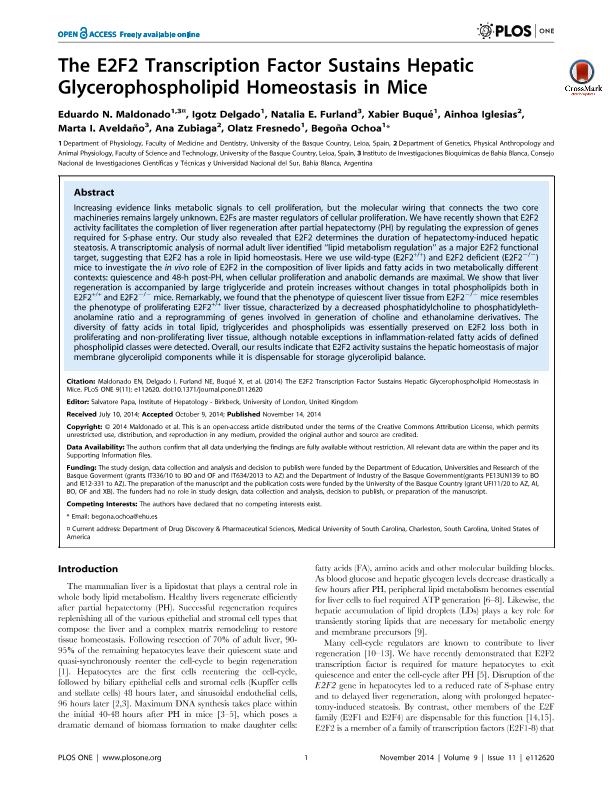Artículo
The E2F2 Transcription Factor Sustains Hepatic Glycerophospholipid Homeostasis in Mice
Maldonado, Eduardo N.; Delgado, Igotz; Furland, Natalia Edith ; Buqué, Xabier; Iglesias, Ainhoa; Aveldaño, Marta Isabel
; Buqué, Xabier; Iglesias, Ainhoa; Aveldaño, Marta Isabel ; Zubiaga, Ana; Fresnedo, Olatz; Ocho, Begoña
; Zubiaga, Ana; Fresnedo, Olatz; Ocho, Begoña
 ; Buqué, Xabier; Iglesias, Ainhoa; Aveldaño, Marta Isabel
; Buqué, Xabier; Iglesias, Ainhoa; Aveldaño, Marta Isabel ; Zubiaga, Ana; Fresnedo, Olatz; Ocho, Begoña
; Zubiaga, Ana; Fresnedo, Olatz; Ocho, Begoña
Fecha de publicación:
11/2014
Editorial:
Public Library Of Science
Revista:
Plos One
ISSN:
1932-6203
Idioma:
Inglés
Tipo de recurso:
Artículo publicado
Clasificación temática:
Resumen
Increasing evidence links metabolic signals to cell proliferation, but the molecular wiring that connects the two core machineries remains largely unknown. E2Fs are master regulators of cellular proliferation. We have recently shown that E2F2 activity facilitates the completion of liver regeneration after partial hepatectomy (PH) by regulating the expression of genes required for S-phase entry. Our study also revealed that E2F2 determines the duration of hepatectomy-induced hepatic steatosis. A transcriptomic analysis of normal adult liver identified "lipid metabolism regulation" as a major E2F2 functional target, suggesting that E2F2 has a role in lipid homeostasis. Here we use wild-type (E2F2+/+) and E2F2 deficient (E2F2-/-) mice to investigate the in vivo role of E2F2 in the composition of liver lipids and fatty acids in two metabolically different contexts: quiescence and 48-h post-PH, when cellular proliferation and anabolic demands are maximal. We show that liver regeneration is accompanied by large triglyceride and protein increases without changes in total phospholipids both in E2F2+/+ and E2F2-/- mice. Remarkably, we found that the phenotype of quiescent liver tissue from E2F2-/- mice resembles the phenotype of proliferating E2F2+/+ liver tissue, characterized by a decreased phosphatidylcholine to phosphatidylethanolamine ratio and a reprogramming of genes involved in generation of choline and ethanolamine derivatives. The diversity of fatty acids in total lipid, triglycerides and phospholipids was essentially preserved on E2F2 loss both in proliferating and non-proliferating liver tissue, although notable exceptions in inflammation-related fatty acids of defined phospholipid classes were detected. Overall, our results indicate that E2F2 activity sustains the hepatic homeostasis of major membrane glycerolipid components while it is dispensable for storage glycerolipid balance.
Palabras clave:
Cells Membranes
,
Fatty Acids
,
Fatty Liver
,
Gene Expression
Archivos asociados
Licencia
Identificadores
Colecciones
Articulos(INIBIBB)
Articulos de INST.DE INVEST.BIOQUIMICAS BAHIA BLANCA (I)
Articulos de INST.DE INVEST.BIOQUIMICAS BAHIA BLANCA (I)
Citación
Maldonado, Eduardo N.; Delgado, Igotz; Furland, Natalia Edith; Buqué, Xabier; Iglesias, Ainhoa; et al.; The E2F2 Transcription Factor Sustains Hepatic Glycerophospholipid Homeostasis in Mice; Public Library Of Science; Plos One; 9; 11; 11-2014; e112620
Compartir
Altmétricas



